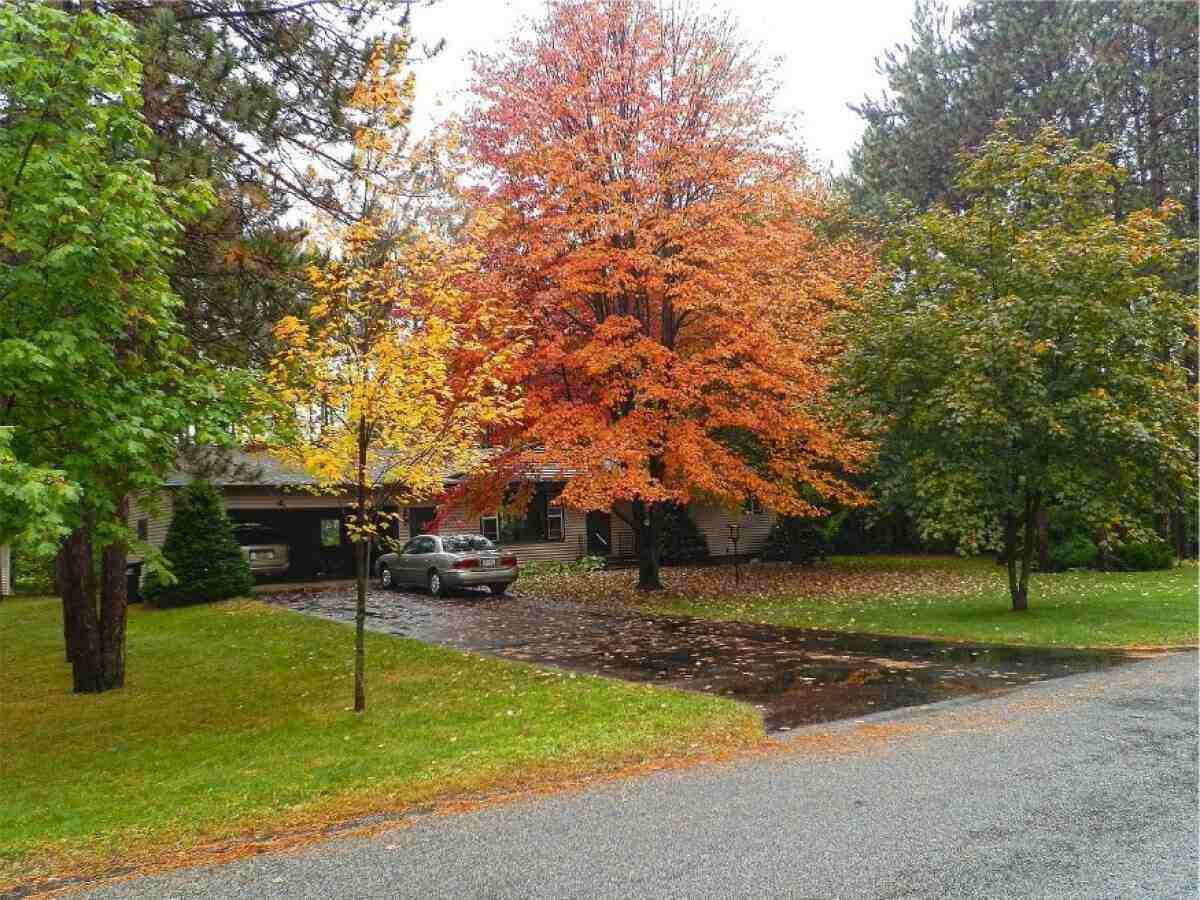
When creating a visually stunning front lawn, the trees you choose play a crucial role. After all, your front yard trees are one of the first things visitors see. But how do homeowners pick and plant a new showpiece tree that makes a statement? We’ll show you how.
Why Should I Plant a Tree in My Front Yard?
There’s something welcoming about the mature canopy of a tree in the front yard. It greets you and your guests, guides you to the front door, and provides shade and comfort during the warm months. And planting trees serves a larger purpose: One full-grown tree absorbs as much as 48 pounds of carbon pollution every year.
The tree you choose for front yard landscaping makes a statement about you and improves the curb appeal for your home. But the benefits don’t end there. Well-placed, healthy trees in front of a house can also increase your property value:
- On average, mature, healthy trees can add 10 percent to a property’s value, according to the USDA Forest Service.
- The appraisal value of a mature tree can range from $1,000 to $10,000, reports the Council of Tree and Landscape Appraisers.
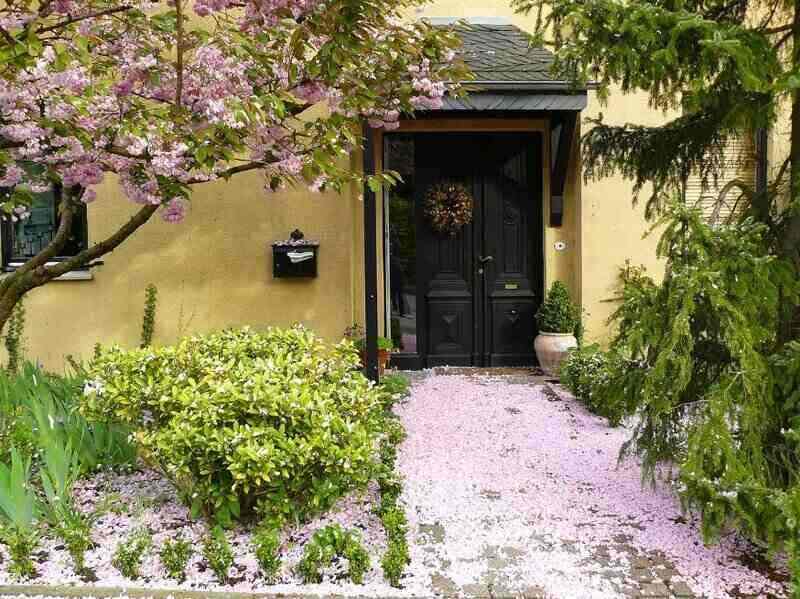
Photo Credit: Peakpx / CC0 1.0
8 Tree Selection Questions
There are various types of trees to choose from. Ornamental trees add a year-round display to your landscape, while fruit trees can provide an additional food source. Consider these eight questions as you select the species best for your front yard tree landscaping.
- What is the ultimate tree size — how wide or tall will the new tree grow?
- What tree shape do you desire — round or oblong, tall or short?
- Should I plant a deciduous tree or an evergreen tree?
- How fast does it grow?
- How long does this type of tree typically live?
- What does it need regarding sun, soil type, or moisture?
- Will it bear fruit or require maintenance I don’t want to provide?
- Will it grow in my USDA hardiness zone?
Considerations for Planting Trees in the Front Yard
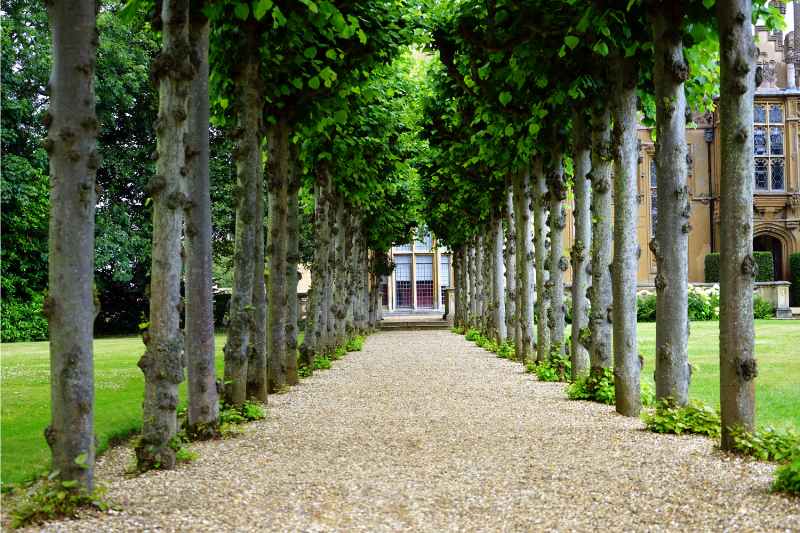
How do you choose the right tree for your front yard and prepare it for a lifetime of good health on your property?
It all begins with careful planning, says Dave Leonard, International Society of Arboriculture (ISA) Board Certified Master Arborist and owner of Dave Leonard Tree Specialists. “There’s a lot more to planting a tree than the average citizen knows.”
Choosing and planting a tree in the front yard involves research of local ordinances, tree placement, growth and behavior of different types of trees, and how the tree will affect your property and the land around it.
One Tree vs. Grouping Several
One beautiful specimen tree can become the star of your yard. Group tree plantings can be a focal point, frame a driveway, or define a space.
Rate of Growth
Leonard suggests combining fast-growing and slow-growing plants to stagger tree life spans. “Fast-growing trees are more commonly weaker and lose limbs that slower-growing trees don’t.”
The rate of growth usually means how tall a tree will grow, not how wide it grows. The rate can vary from tree to tree depending on soil health, drainage, light, and other factors. Faster-growing trees may need more trimming.
According to the Arbor Day Foundation:
- Slow growth means the tree grows 12 inches or less annually.
- Medium growth is 13-24 inches per year.
- Fast growth is 25 inches of growth or more annually.
So you know what kind of tree you want and the rate at which you can expect it to grow. A few final checks, and you’ll be ready to plant your tree.
Check Utilities, Permits, and Restrictions
Call your local zoning departments to find out if there are planting or tree variety restrictions. Obtain permits if necessary.
Call 811 to locate and mark underground utility lines, pipes, or cables or to consult about power lines for free.
Know where your property lines are, and make sure the mature tree will not grow into your neighbor’s land.
Mature Size and Site Considerations
“Planting area size is of huge importance for the life span of the tree…,” advises Leonard. “This is extremely important. Also consider site moisture, clearance requirements, undesirable fruit, such as large acorns, messy fruit, and slope.”
What Bugs Trees in Your Area?
“Know your insect and disease issues in the area,” warns Leonard. “Emerald ash borer has decimated our eastern urban forests and is moving west and south, and there are many other issues.”
“You should always consider the tree species population in a city as we don’t want too many of one species. The loss of the ash trees has seriously impacted the health of many people where cities lost large percentages of them.”
Plant With Sun in Mind
What direction does your front yard face? Will the tree block the winter sun, or will it cool the house with welcome shade in the summer? Will the large trees block full sun for the flower beds or vegetable garden?
Answering these questions will impact front yard tree placement. “In the northern hemisphere, it is good to plant deciduous trees on the southwest side of the house,” says Leonard. “If it’s really windy, you can use evergreens for a windbreak or a screen.”
Step Away from the Foundation
When planting trees in the front yard, make sure to choose an area that is at least 15-20 feet from the house to prevent problems with roots or with overhanging branches.
Research the mature size of the tree or trees you have in mind. A tree with a spreading root system, like weeping willows, may need to be located farther away from the house. Or you may choose a different tree that is less invasive or has a smaller canopy.
Soil Type and Wildlife
Soil health should be taken into consideration as well. Heavy clay soil can cause more roots to grow near the soil’s surface, which could become a problem. Adding mulch will improve your soil.
Last but certainly not least, the tree you choose might become a home for birds and other creatures, and its flowers and pollen will help the local pollinator population. Anyone can have a bee-friendly lawn. One well-chosen tree can make a big difference!
Best Trees to Plant in Your Front Yard
The best front yard tree ideas include:
Slow-Growing Trees
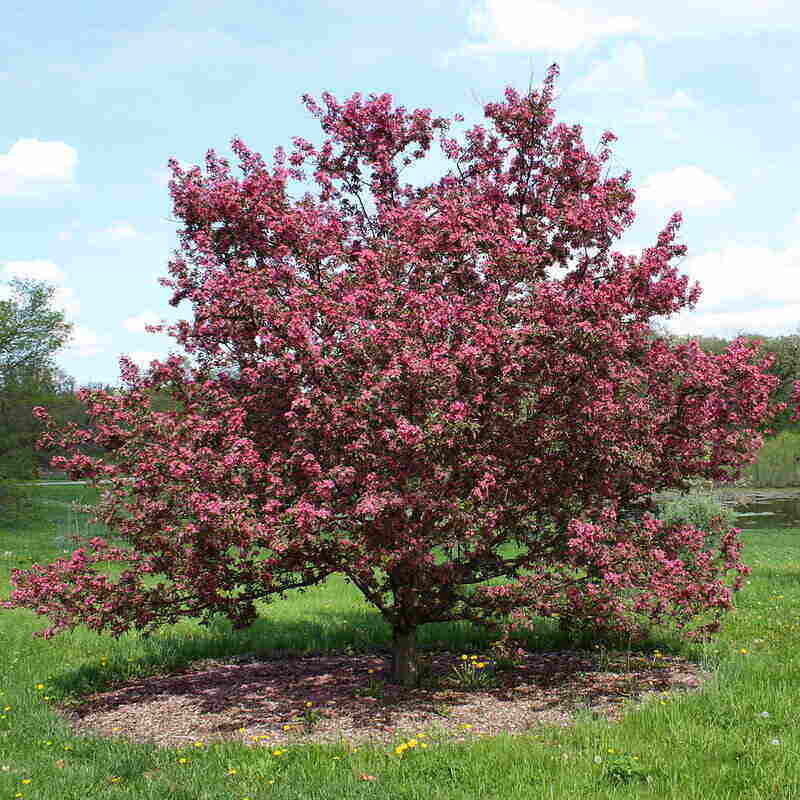
Photo credit: Bruce Martin / Wikimedia Commons / CC0 1.0
- Black tupelo (Nyssa sylvatica): Slow to medium growth. Fall leaves can change to many different shades of red, yellow, purple, or orange — more than one color may appear on the same branch. Zones 4 to 9.
- Crabapple (Malus): Slow growth. The variety of crabapple called the ‘Sargent’ is one of the slowest-growing crabapples. It is easily pruned to a desired height. It’s a flowering tree that bears tiny red fruit in the fall. Zones 3 to 9.
- Japanese Maple (Acer palmatum): Slow growth. Many varieties of Japanese maples have burgundy leaves that turn crimson in the fall. Zones 5 to 8.
- Snow Fountains Weeping Cherry (Prunus x ‘Snofozam’): Slow growth. Hanging or “weeping” branches have white flowers in the spring. Zones 4 to 8.
Medium-Growing Trees
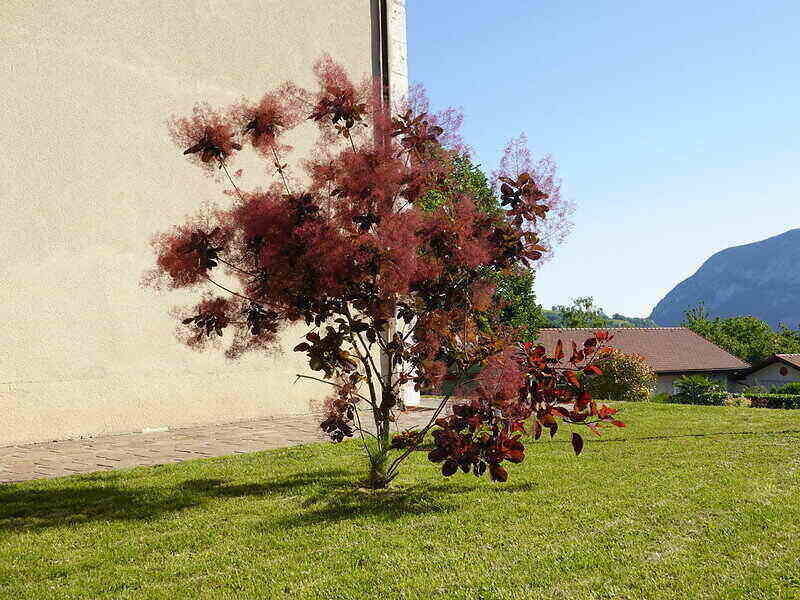
Photo Credit: Guilhem Vellut / Flickr / CC by 2.0
- American Redbud (Cercis canadensis): Medium growth. Pink flowers in April. Zones 4 to 9.
- Eskimo Sunset Sycamore Maple (Acer pseudoplatanus ‘Esk Sunset’): Medium growth. New leaves are pinkish-orange and mature to color-splashed green with purple on the abaxial side of the leaf. Zones 5 to 8.
- Fox Valley Dwarf River Birch (Betula nigra ‘Little King’): Medium growth. Small tree with pretty, exfoliating bark. Zones 4 to 10.
- Ivory Halo Dogwood (Cornus alba ‘Bailhalo’): Medium growth. Creamy green and white variegated leaves. Zones 3 to 7.
- Smoke Tree (Cotinus coggygria): Medium growth. This small tree has tiny seed clusters that turn smoky pink or gray through the summer. Zones 5 to 8.
- Thundercloud Purple Leaf Plum (Prunus cerasifera ‘Thundercloud’): Medium growth. Burgundy to purple foliage and pink blooms in the spring, turning to edible red fruits. Zones 4 to 9.
Medium-Fast Growing Trees
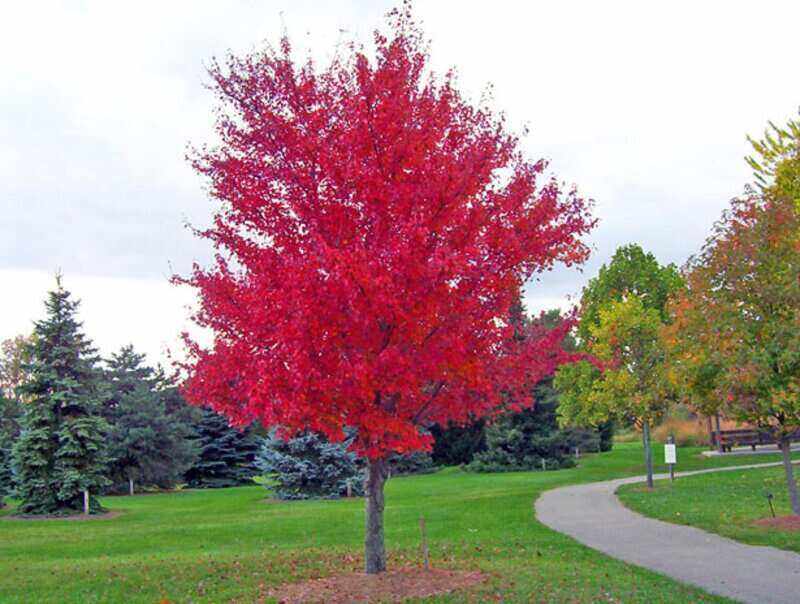
Photo Credit: David Wagner / PublicDomainPictures / CC0 1.0
- Red Maple (Acer rubrum): Medium to fast growth. New leaves are red-trimmed and turn green, then dark red or yellow in the fall. Zones 5 to 9.
- Dwarf Alberta Spruce (Picea glauca ‘Conica’): Medium to fast growth, but this evergreen is only 4 to 5 feet tall at maturity. Zones 2 to 6.
Fast-Growing Trees
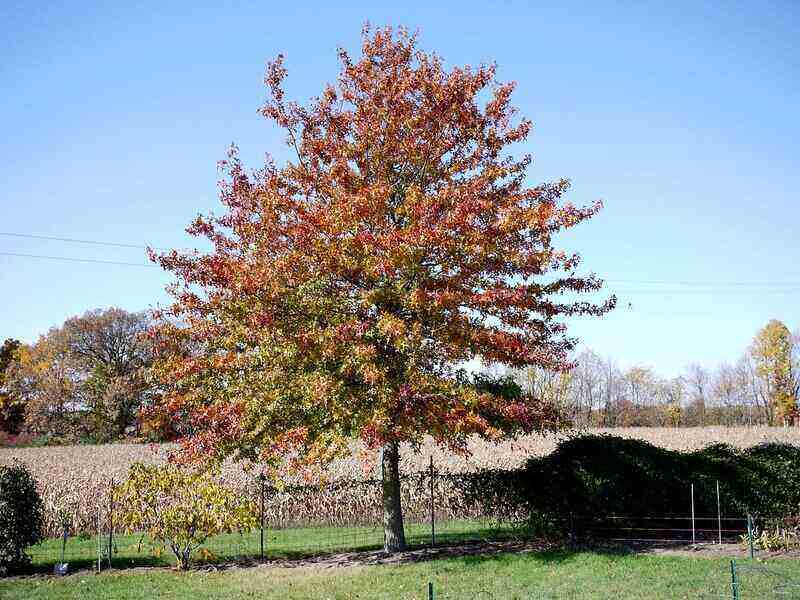
Photo Credit: F. D. Richards / Flickr / CC BY-SA 2.0
- Cleveland Select Flowering Pear Tree (Pyrus calleryana ‘Cleveland Select’): Fast growth. Bluish fruit that ripens in the early fall. Leaves change to many colors, from bright yellow to deep red, in the fall. Zones 4 to 9.
- Pin Oak (Quercus palustris): Fast growth. Leaves turn russet in the fall. Zones 4 to 8.
- Tulip Tree (Liriodendron tulipifera) Fast growth. Aromatic stems and yellowish flowers. Leaves turn yellow in the fall. Zones 4 to 9.
What Size Tree is Best for Your Front Yard?
Large Trees: “Large deciduous trees benefit properties the most, but it depends on several factors,” says Leonard. A tree in front of a house should be appealing from the view of the street but should not overwhelm the house itself.
A large shade tree can reduce energy costs by as much as 50 percent annually by cooling the home in summer and providing a windbreak in winter months.
Small and Dwarf Trees: Compared to the larger trees, the cost of planting small trees and dwarf varieties may not be as much, and their shorter mature height will prevent damage from overhanging branches. They also may have colorful flowers or interesting branch patterns that add to the beauty of the landscape design.
FAQ About Planting Trees
What Trees Should Not be Planted Close to a House?
As a rule, think about the tree height at maturation and plant your tree at a safe distance from your home based on that information. There are a few exceptions where the tree roots are notoriously invasive and should not be planted close to home:
• Poplar and aspen
• Silver maple
• Willow
What Trees Can I Plant in a Small Backyard?
Here are a few small trees (less than 25 feet) that are perfect for a small backyard:
• Crepe myrtle
• Deciduous magnolias
• Dogwood
• Dwarf southern magnolia
• Japanese maples
• Possumhaw holly
• Redbud
• Vitex
• White fringetree
Do I Need a Permit to Plant a Tree in My Front Yard?
Sometimes you need a permit for front yard trees, but it depends where you live. If you live in a rural area, chances are you can plant whatever you want, wherever you want — as long as it doesn’t interfere with power lines. But if you live in a suburb or an urban area, you’ll probably have to follow some guidelines and potentially get a permit.
Oregon City, for example, has a list of guidelines, and you’ll need a permit for certain scenarios. If you live in an HOA, you’ll almost certainly have rules to follow. Check your local town, city, or county websites to be sure.
Hire a Professional
Trees can be a beast all their own. Choosing, planting, and maintaining trees can be time-consuming and labor-intensive, taking time away from what’s important to you.
Thankfully, local, experienced, highly rated professionals are nearby to help with the load. A free and easy quote from a local landscape professional is just a call or click away. Whether you’re looking for information or to hire a professional today, we’ve got you covered.
Main image credit: manneyd / Pixabay